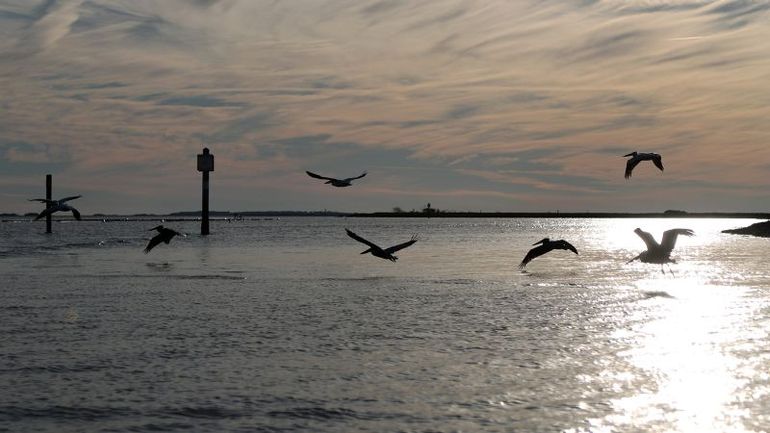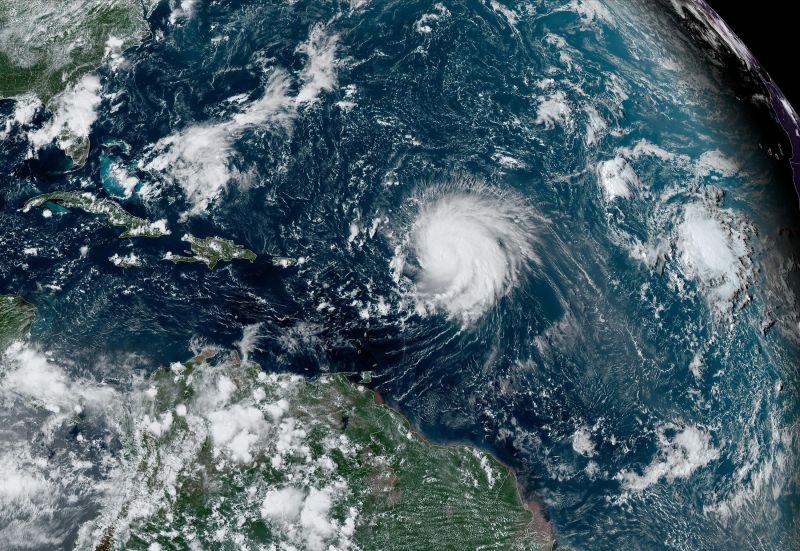
Experts Warn of Ocean Crisis as Funding Cuts Threaten Vital Research

As experts race to unravel the mystery behind the unprecedented heat levels in the world's oceans, crucial research funding in the US is at risk of being slashed, potentially halting critical studies during a pivotal moment for our planet.
Scientists are currently trying to figure out why the world's oceans are experiencing record-breaking heat for the second year in a row. At the same time, one of the most important programs in the US that collects ocean data is at risk of shutting down, potentially halting crucial research efforts for the planet.
The program, known as the Integrated Ocean Observing System (IOOS), is like the "eyes" of the oceans along the US coasts. It is a lesser-known but essential initiative under the National Oceanic and Atmospheric Administration. With a network of over 1,000 monitoring instruments, IOOS tracks various aspects of the oceans and the Great Lakes such as currents, water temperature, oxygen levels, acidification, and algae. This data is valuable for both government and non-government users.
IOOS data is valuable for various purposes such as hurricane forecasting, fisheries, and Coast Guard search and rescue. For example, it can assist the Coast Guard in reducing search areas by two-thirds.
Unfortunately, despite President Joe Biden's ambitious climate goals, his recent budget proposal includes a significant cut in funding for the IOOS program. The proposed cut would reduce funding from $42.5 million to $10 million, which is a decrease of more than 75%. This cut is much deeper than those proposed during the previous Trump administration.
Unless Congress increases funding, the program will suffer greatly, according to researchers. Without additional funds, new instruments cannot be added, and existing buoys collecting data for years will have to be removed.
Gerhard Kuska, a marine scientist overseeing the program in the mid-Atlantic region, expressed concern about the potential consequences. He explained that the program would essentially go dark, risking the interruption of years of valuable data collection.
ATLANTIC OCEAN - SEPTEMBER 8: In this NOAA image taken by the GOES satellite, Hurricane Lee crosses the Atlantic Ocean as it moves west on September 8, 2023. Lee reached Category 5, but then weakened slightly to Category 4 as it expected to be a dangerous storm as it moves over the southwest Atlantic. It is too early to know if it will directly affect the United States. (Photo by NOAA via Getty Images)
Hurricane Lee was captured in this image by the GOES satellite on September 8, 2023, as it made its way across the Atlantic Ocean. Initially reaching Category 5 status, it later dropped to Category 4. Forecasters predict that it will pose a significant threat as it continues to move towards the southwest Atlantic. It is still uncertain whether the United States will be directly impacted by the storm.
NOAA/Handout/Getty Images
Related article
Global ocean heat has been setting new records every day for the past year.
Kuska was shocked when he learned that Biden's budget allocated nearly $70 million for the IOOS program during his first year in office.
Kuska expressed concern about the proposed cuts, stating that they go against the administration's priorities on ocean justice and climate policies. He found it illogical and indefensible to suddenly withdraw support.
The White House Office of Management and Budget chose not to comment on CNN's inquiries. In response, NOAA spokesperson Scott Smullen assured that the agency will try to minimize the negative effects of the budget cuts.
Scientists involved in the IOOS program emphasize the importance of maintaining instruments that transmit data crucial for understanding ocean changes. This is particularly crucial during this time, as the data helps us comprehend shifts in ocean conditions over both short and long periods.
The world's oceans have been facing a year of extreme heat, as reported by CNN. Each day sees a new temperature record being broken, with global average ocean temperatures rising by 0.25 degrees Celsius compared to the previous year. This increase is equivalent to twenty years of warming happening in just one year. The rise in temperature has had devastating effects, leading to the death of coral reefs and the rapid intensification of hurricanes into powerful megastorms.
Bering Sea snow crab support a valuable commercial fishery.
Bering Sea snow crab support a valuable commercial fishery.
NOAA Fisheries
Related article
Billions of crabs went missing around Alaska. Scientists now know what happened to them
Ocean data collection is crucial for gaining a true understanding of what is happening in the oceans, according to Kristen Yarincik, the executive director of the IOOS Association, a nonprofit organization that collaborates with NOAA to collect data.
Yarincik expressed the importance of determining whether certain occurrences in the ocean are the new normal or just temporary fluctuations. Identifying these events in real-time is essential, but placing them in context and analyzing if they represent a lasting change is equally important.
IOOS instruments provide essential data for hurricane forecasting and predicting storm intensification.
According to marine scientist Ellen Prager, the data collected from ocean observations is crucial for improving forecast models.
Another important aspect of the program involves placing affordable flood sensors in various communities across the country. These sensors help communities monitor water levels in real time.
IOOS has recently installed 97 water level stations along the coastlines of the Carolinas, Georgia, and Florida. This is three times more than the 32 sensors put in place by NOAA in the Southeast region for its National Water Level Observing Network, which monitors sea level rise.
While NOAA's instruments are more advanced and expensive, IOOS water level sensors are simpler and more cost-effective. This allows for a wider deployment in various locations, bridging the gaps and providing real-time flooding data to more communities.
“We’re just getting to a lot more places,” said Debra Hernandez, executive director of the Southeast regional association running ocean observations.
This photo taken on January 10, 2022 shows a worker (bottom C) sitting at a desk next to the Korean 'artificial sun', the Korea Superconducting Tokamak Advanced Research device (KSTAR), at the Korea Institute of Fusion Energy (KFE) in Daejeon. (Photo by ANTHONY WALLACE / AFP) (Photo by ANTHONY WALLACE/AFP via Getty Images)
On January 10, 2022, a worker is seen sitting at a desk next to the Korean 'artificial sun', known as the Korea Superconducting Tokamak Advanced Research device (KSTAR). The photo was taken at the Korea Institute of Fusion Energy (KFE) in Daejeon. The image was captured by Anthony Wallace and is courtesy of AFP/Getty Images.
Related article
‘Artificial sun’ sets record for time at 100 million degrees in latest advance for nuclear fusion
Communities can benefit greatly from the use of sensors, according to Hernandez. These sensors assist police and emergency responders in monitoring the water levels and preparing their response. In case of a need for evacuation, the sensors can notify community members. Additionally, they can inform people when the water has gone down and it is safe to go back home.
Furthermore, the sensors have the capability to track the maximum water levels in specific areas.
"It gives them a local reality check," Hernandez explained. "Our goal is to empower communities to share their own stories and provide data that engineers and town officials can rely on. Sometimes, presenting a graph or chart with scientific evidence can be more persuasive than an emotional appeal."
Hernandez expressed concern that the water level sensors may be among the first items to be cut if IOOS funding is reduced in the budget.
“We would not be able to maintain most of those systems,” Hernandez said. “At least half of the water level sensor network would be compromised with this funding cut.”
Editor's P/S:
The article highlights the crucial role of the Integrated Ocean Observing System (IOOS) in monitoring and understanding the world's oceans, particularly amid record-breaking ocean heat. However, the proposed significant cut in funding for IOOS raises grave concerns. This drastic reduction threatens the continuation of vital research efforts, jeopardizing our ability to comprehend ocean changes and their implications for the planet.
The data collected by IOOS is invaluable for various purposes, including hurricane forecasting, fisheries management, and Coast Guard search and rescue operations. The proposed budget cut would severely hamper these essential services, potentially putting lives at risk. Additionally, the loss of IOOS instruments would disrupt years of valuable data collection, making it challenging to track long-term ocean trends and assess the effectiveness of climate change mitigation strategies. It is imperative that Congress and the Biden administration reconsider the proposed funding reduction and prioritize the preservation of this critical program for the health of our oceans and the well-being of coastal communities.










